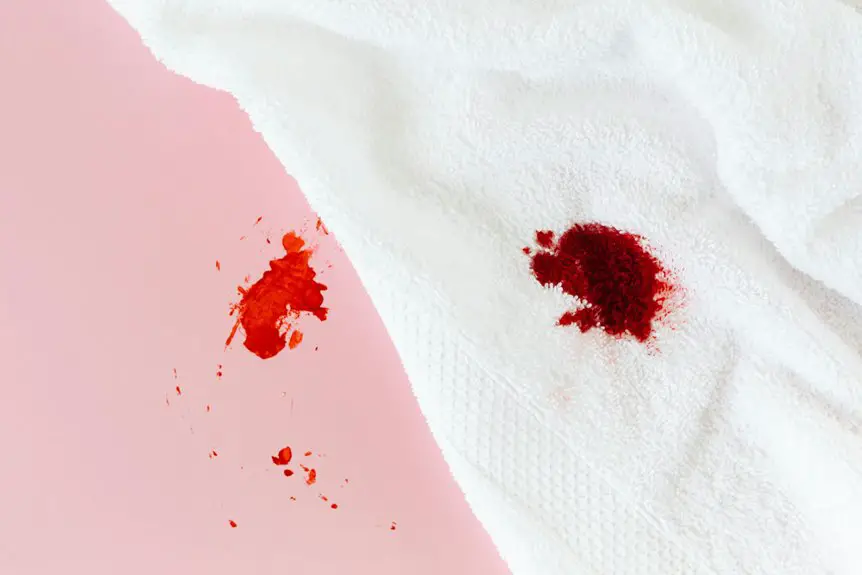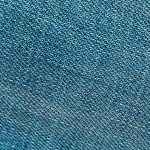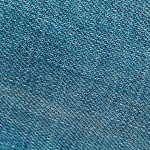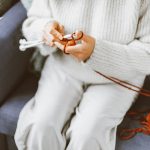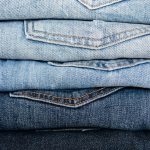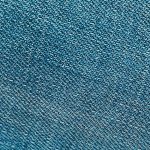You can identify the selvedge edge by looking for a tightly woven, smooth border running parallel to the fabric’s length. It won’t fray like cut edges and often features a distinct colored line or pattern. You’ll notice it feels firmer and more stable than the rest. Pay close attention to texture and weave differences to avoid confusion. If you want to understand how the selvedge works across different fabrics and avoid common mistakes, keep exploring this guide.
Table of Contents
Key Takeaways
- Look for a tightly woven, smooth edge running parallel to the fabric length, without any fraying or loose threads.
- Identify any colored lines or patterns along the edge, common in denim and other fabrics, marking the selvedge.
- Compare edges to distinguish the selvedge from raw cut edges, which are uneven and prone to unraveling.
- Use light to highlight texture differences, noting the selvedge’s consistent width and firm weave versus the fabric body.
- Avoid confusing folded edges or decorative threads with the selvedge by checking for continuous woven threads along the fabric length.
Understanding the Purpose of the Selvedge
Although it might seem like just an edge, the selvedge plays an essential role in fabric construction. When you handle fabric, the selvedge prevents the sides from unraveling or fraying. It’s tightly woven alongside the fabric’s length, creating a strong boundary that holds everything together.
You’ll find it runs parallel to the warp threads, ensuring stability during weaving and later when you work with the fabric. Because it’s designed to be durable, the selvedge helps maintain the fabric’s shape, which is vital for cutting and sewing.
Visual Characteristics of the Selvedge Edge
Now that you know why the selvedge is important, you can learn how to spot it on your fabric. The selvedge edge usually runs parallel to the fabric’s length and looks different from the cut edges. It often has a tighter weave, preventing fraying. You might also notice a distinct color or stripe along the edge, which manufacturers use as an identifier.
Here’s a quick table to help you recognize common visual traits of the selvedge edge:
| Visual Trait | Description |
|---|---|
| Tighter weave | Denser threads for durability |
| Color or stripe | Often a colored line or pattern |
| Smooth edge | No loose threads or fraying |
| Parallel orientation | Runs lengthwise, not crosswise |
| Consistent width | Uniform edge width throughout |
Differences Between Selvedge and Cut Edges
When you compare selvedge edges to cut edges, you’ll notice they serve very different purposes. Selvedge edges run along the fabric’s length, designed to prevent fraying and maintain integrity. Cut edges, however, are freshly sliced and prone to unraveling if left untreated.
Selvedge edges run lengthwise to prevent fraying, while cut edges are raw and need finishing.
Here’s how they differ:
- Selvedge edges feel sturdy and finished, giving you confidence in your fabric’s durability.
- Cut edges look raw and uneven, often requiring hemming or sealing.
- Selvedge edges carry woven threads that run continuously, showing craftsmanship.
- Cut edges can fray easily, demanding extra care during sewing.
Recognizing these differences helps you handle fabric wisely and avoid surprises in your projects.
How to Feel the Selvedge Edge by Touch
One of the easiest ways to identify the selvedge edge is by running your fingers along the fabric’s side.
You’ll notice it feels tighter and denser compared to the rest of the fabric. The threads here are packed closer together, creating a firm, smooth line.
Unlike the cut edge, which often feels loose or frayed, the selvedge edge is clean and uninterrupted. As you move your fingers, you might feel a slight ridge or firmness that sets it apart.
This tactile difference happens because the selvedge prevents unraveling during weaving. By trusting your sense of touch, you can quickly distinguish the selvedge edge without needing to rely solely on visual clues.
This skill comes in handy when working with unfamiliar fabrics.
Identifying Selvedge on Various Fabric Types
When you look closely, each fabric type shows unique woven edge characteristics that help you spot the selvedge.
You’ll notice differences in thickness, texture, and finish depending on whether the fabric is denim, linen, or cotton.
Paying attention to these details makes it easier to differentiate the selvedge across various materials.
Woven Edge Characteristics
Although selvedge edges vary across fabric types, you can usually spot them by their tightly woven, finished appearance that prevents unraveling.
When you examine the woven edge, look for a few key characteristics that stand out:
- A clean, firm border running parallel to the fabric’s length
- Threads that are more densely packed than the rest of the fabric
- Sometimes a colored line or pattern woven directly into the edge
- A slight stiffness compared to the softer interior fabric
These features mean the edge was intentionally finished during weaving, not cut afterward.
By recognizing these traits, you’ll confidently identify the selvedge, ensuring your projects use fabric that won’t fray or weaken at the edges.
Keep this in mind as you handle different fabrics next time!
Differentiating Fabric Types
Recognizing the selvedge’s unique features helps you spot it across different fabric types, but each fabric can present distinct challenges. For example, cotton’s selvedge is often tightly woven and crisp, while silk’s edge might appear smoother yet delicate. Denim typically displays a colored line along its selvedge, aiding identification. Understanding these differences guarantees you correctly identify the selvedge regardless of fabric.
| Fabric Type | Selvedge Appearance | Identification Tip |
|---|---|---|
| Cotton | Tightly woven, firm edge | Look for crisp, clean finish |
| Silk | Smooth, delicate edge | Check for slight sheen |
| Denim | Colored line, sturdy edge | Notice the distinctive stripe |
| Linen | Coarser, rougher edge | Feel the texture for firmness |
| Wool | Thick, sometimes fuzzy | Observe thickness and texture |
Using the Selvedge to Align Pattern Pieces
You’ll want to use the selvedge as a guide to align your pattern pieces properly.
By matching the grainline on your pattern with the selvedge, you guarantee your fabric lays flat and your seams stay straight.
This helps you straighten pattern edges and maintain the fabric’s natural grain for the best fit and finish.
Grainline and Selvedge
One key step in sewing is aligning your pattern pieces correctly using the grainline and selvedge. The grainline runs parallel to the selvedge, guiding you to place your patterns so your garment hangs and stretches properly.
When you align the grainline with the selvedge, you guarantee fabric stability and avoid distortion.
Keep in mind:
- The selvedge is your fabric’s natural edge, perfect for alignment.
- Grainline markings on patterns indicate the fabric’s lengthwise direction.
- Proper alignment prevents twisting and uneven seams.
- Ignoring grainline and selvedge can ruin your garment’s fit and drape.
Straightening Pattern Edges
Since the selvedge runs straight and won’t fray, you can use it as a reliable guide to straighten your pattern edges.
Lay your fabric flat with the selvedge clearly visible. Place your pattern piece along the selvedge, aligning one edge of the pattern parallel to it. This helps guarantee your pattern edge is perfectly straight before cutting.
If the pattern edge isn’t straight, gently rotate the piece until it lines up with the selvedge’s edge. Pin or weigh down the pattern to keep it in place.
Using the selvedge this way minimizes distortion and helps maintain accurate shapes. Straightening pattern edges with the selvedge reduces fabric waste and improves the fit of your finished project by keeping your cuts precise and clean.
Aligning With Fabric Grain
After straightening your pattern edges using the selvedge, the next step is to align your pattern pieces with the fabric grain. This alignment guarantees your garment hangs properly and maintains its shape over time.
The selvedge runs parallel to the fabric grain, so use it as your guide to position each pattern piece. When you do this, you’ll avoid stretching or distorting the material during sewing.
Keep these points in mind when aligning pattern pieces:
- Trust the selvedge for the grainline direction
- Pin or weigh down pieces to prevent shifting
- Double-check grainline markings on your pattern
- Remember, proper alignment impacts fit and durability
Common Mistakes When Identifying the Selvedge
How can you avoid common pitfalls when trying to spot the selvedge edge?
First, don’t confuse folded edges or cut edges with the selvedge. The selvedge runs continuously along the fabric’s length, unlike cut edges that appear uneven or frayed.
Also, avoid mistaking decorative selvage threads or printed markings for the true edge—they’re often near but not the actual selvedge.
Another mistake is ignoring the fabric grain; the selvedge always runs parallel to it.
Finally, don’t overlook the fact that some fabrics have subtle or plain selvedges, so you might need to look closely for tighter weaving or a different thread pattern.
Frequently Asked Questions
Can Selvedge Edges Affect Fabric Shrinkage After Washing?
Yes, selvedge edges can affect fabric shrinkage after washing because they’re tightly woven, preventing fraying and reducing shrinkage along the edges. You’ll notice less distortion compared to the cut edges of the fabric.
Is Selvedge Edge Stronger Than the Rest of the Fabric?
Yes, the selvedge edge is usually stronger because it’s tightly woven to prevent fraying. When you handle fabric, you’ll notice it’s more durable along the selvedge compared to the rest of the material.
How Does Selvedge Edge Impact Fabric Waste in Cutting?
You can reduce fabric waste by up to 15% when you consider the selvedge edge during cutting. Since it’s stronger and less prone to fraying, you’ll minimize scrap and optimize your material usage efficiently.
Can Selvedge Edges Be Dyed Differently From the Main Fabric?
Yes, you can dye selvedge edges differently from the main fabric. Since they’re woven tightly, they often absorb dye uniquely, letting you create contrasting colors or patterns that add character and distinction to your finished piece.
Are Selvedge Edges Used in Quilting or Only Garment Sewing?
You’ll find selvedge edges used in both quilting and garment sewing. Quilters often appreciate the tighter, finished edge for stability, while garment makers rely on it to prevent fraying during construction and wear.
- Does Chiffon Fabric Stink - July 15, 2025
- Does Chiffon Fabric Affect the Economy - July 15, 2025
- Does Cotton Fabric Have a Nap - July 15, 2025

